The biggest entertainment stories
Get our big stories about Hollywood, film, television, music, arts, culture and more right in your inbox as soon as they publish.
You may occasionally receive promotional content from the Los Angeles Times.

There are few artists who can claim they have shaped the literal landscape of Los Angeles. Artist Judy Baca is one of them.
For more than 50 years, she has led workshops and projects that not only have added hundreds of murals to the city’s walls, they’ve employed at-risk youth and served as gang intervention programs. In the 1970s, she and artists Christina Schlesinger and Donna Deitch founded the Social and Public Art Resource Center, known as SPARC, an artistic hub that has served as a training ground for generations of artists.
George Lucas’ museum of narrative art acquires Judith F. Baca’s concept drawings and other papers related to her half-mile-long mural in the Valley.
That same decade, Baca launched a collaborative project to paint a half-mile-long mural in the Tujunga Flood Control Channel in North Hollywood. It told the history of California from prehistory to the 1950s — a project that, in retrospect, was prescient for the ways it presented the histories of migrants and Indigenous people. “The Great Wall of Los Angeles,” as the piece has come to be known, is now a veritable monument, figuring in the National Register of Historic Places.
Baca, 75, shows little sign of slowing down. She is working on expanding the mural thanks to a $5 million grant from the Andrew W. Mellon Foundation. And the Lucas Museum of Narrative Art recently acquired the archive related to “The Great Wall” project. On the pop culture front, Baca recently collaborated with Vans and the Museum of Contemporary Art on a special-edition sneaker inspired by one of her murals.
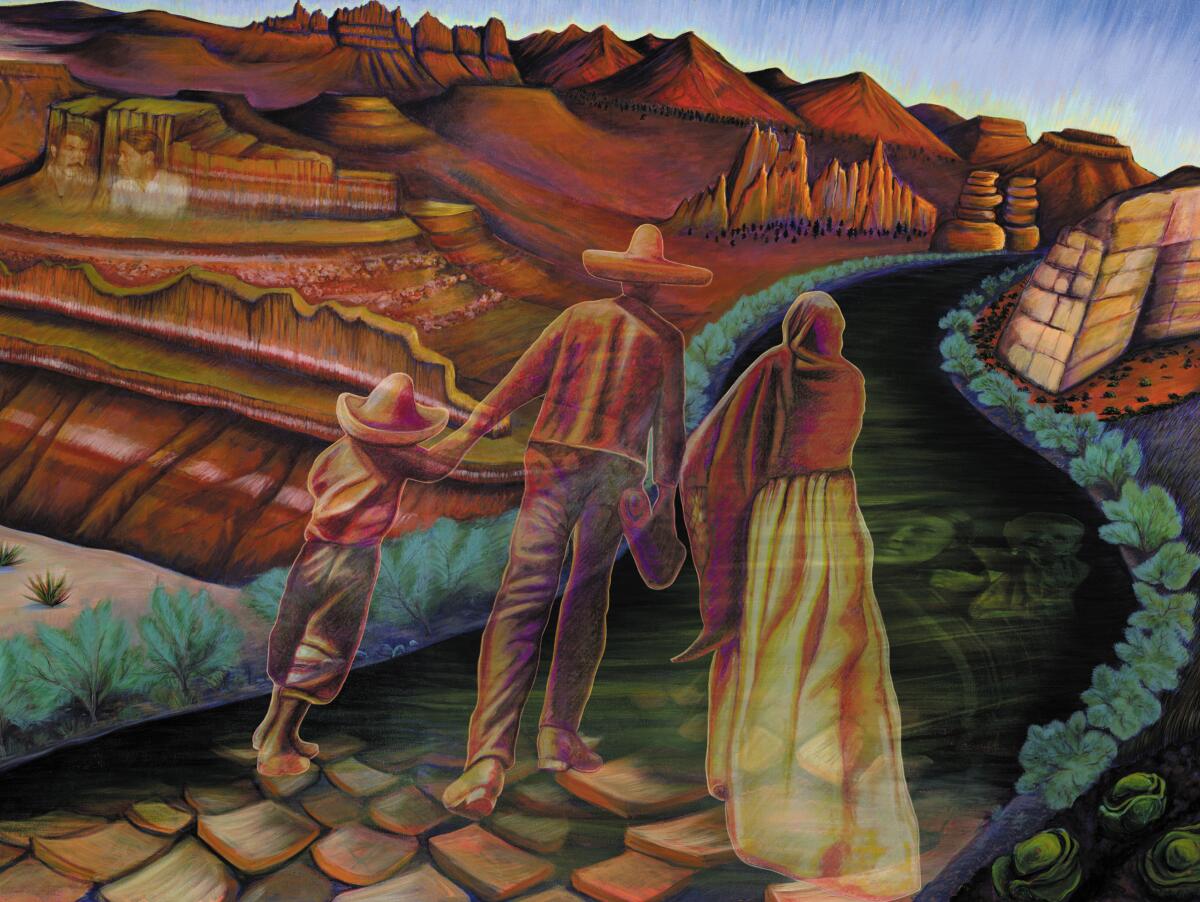
Currently, the artist is the subject of a retrospective at the Museum of Latin American Art (MOLAA) in Long Beach. “Judy Baca: Memorias de Nuestra Tierra, A Retrospective,” which gathers more than 110 works of art including paintings, sculptures, preparatory drawings and sketchbooks, was organized by independent curator Alessandra Moctezuma and MOLAA’s chief curator, Gabriela Urtiaga.
On a crisp November afternoon, Baca sat down in SPARC’s Venice headquarters — a 1920s jailhouse — to talk about the forces that have shaped her career. In this edited oral history, she talks about pachucas, monument design and the obscure all-Chicana exhibition from the 1970s that is just beginning to draw interest.
The MOLAA retrospective features portraits of Baca dressed as a pachuca, pouting and snarling with ruby red lips and teased-out hair — images captured by SPARC co-founder Deitch, a photographer and filmmaker. Baca is known as a muralist, but this early conceptual work emerged from a show that the Woman’s Building co-founder Sheila de Bretteville invited her to organize for the space in 1976.
“Las Chicanas: Venas de la Mujer” now is thought to be the first all-Chicana art exhibition in Los Angeles. It featured work by Baca, Isabel Castro, Judithe Hernandez, Olga Muñiz and Josefina Quezada.
Sheila came to me and said, do we want to do a show that is inclusive of women of color? At the time, [Chicana] women weren’t showing separately from the men. The idea of separating yourself from the men was undermining the movement. I didn’t care. I mean, I cared about the movement. But what I didn’t care about was the incredible machismo. I was having my consciousness raised, partly through my friend Christina [Schlesinger].
Through the mural programs, I knew all of these women. We sat down and we brainstormed and we came up with “Venas de la Mujer” and we all took on different aspects of a woman’s character. We got all dressed up. Judithe was a mourning character. Josefina, I believe she was a factory worker. Isabel Castro, she became the revolutionary. I became the pachuca. Nobody recognized me. I was becoming my cousin Esther — that is her exactly. In school, I was constantly running from them. I got beat up once pretty good by pachucas. That show was about that power, taking the façade.
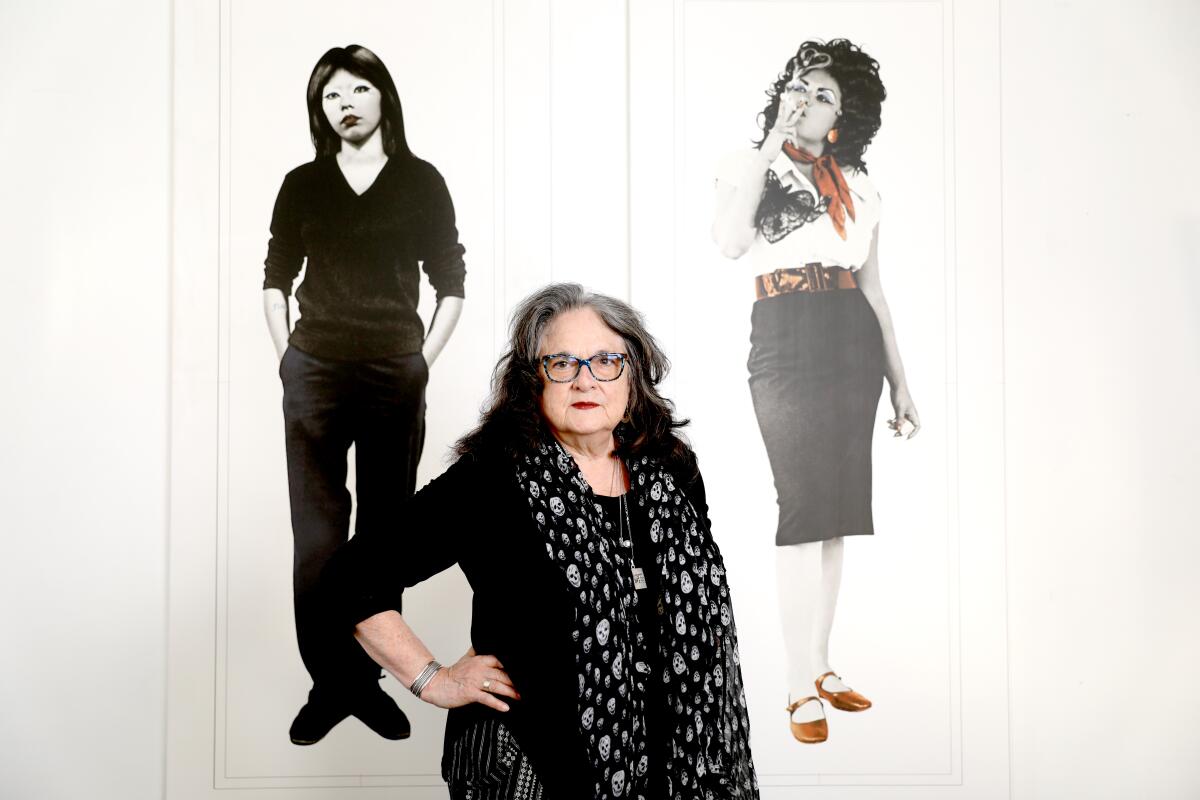
I did another thing too. I brought the Tiny Locas and the Cyclonas, they were two clicas, neighborhood cliques. They were 14 or 15 and there was one group of girls, they were hard-core cholas. We made a big corazón on the wall behind my sculpture “Las Tres Marías” [now in the collection of the Smithsonian American Art Museum]. Out of the veins of the heart, we put the names of the different girls.
Back then, nobody cared about that show. Nobody wrote about it. Nobody spoke about it. It was like it never occurred. But it has started to get more attention recently.
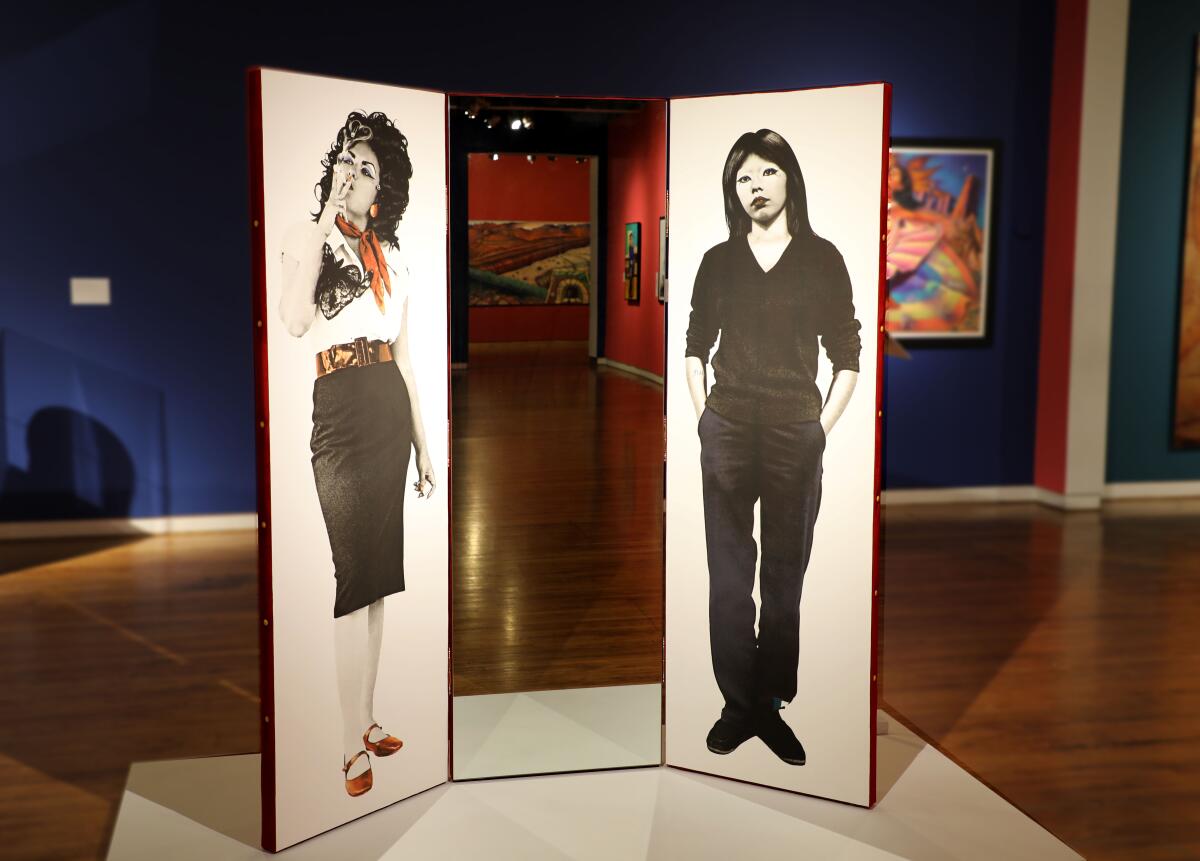
The exhibition at MOLAA provides a rare opportunity to see a more private facet of Baca’s work: her sketch journals.
I’ve always been doing large-scale public work, which is very visible. But the other is that I’ve been doing these intimate, tiny, highly articulated ink drawings, line drawings. A lot of them are funny and weird critiques of whoever crosses my radar or pisses me off. [Laughs.]
I start thinking, I start drawing. See that drawing up there? [Baca points to a sketch on the wall that shows the rough outlines of figures in black ink and a series of quotations.] It has all of this language in it because Tom Hayden [the late activist and California Assemblyman] had been here while I was working on this.
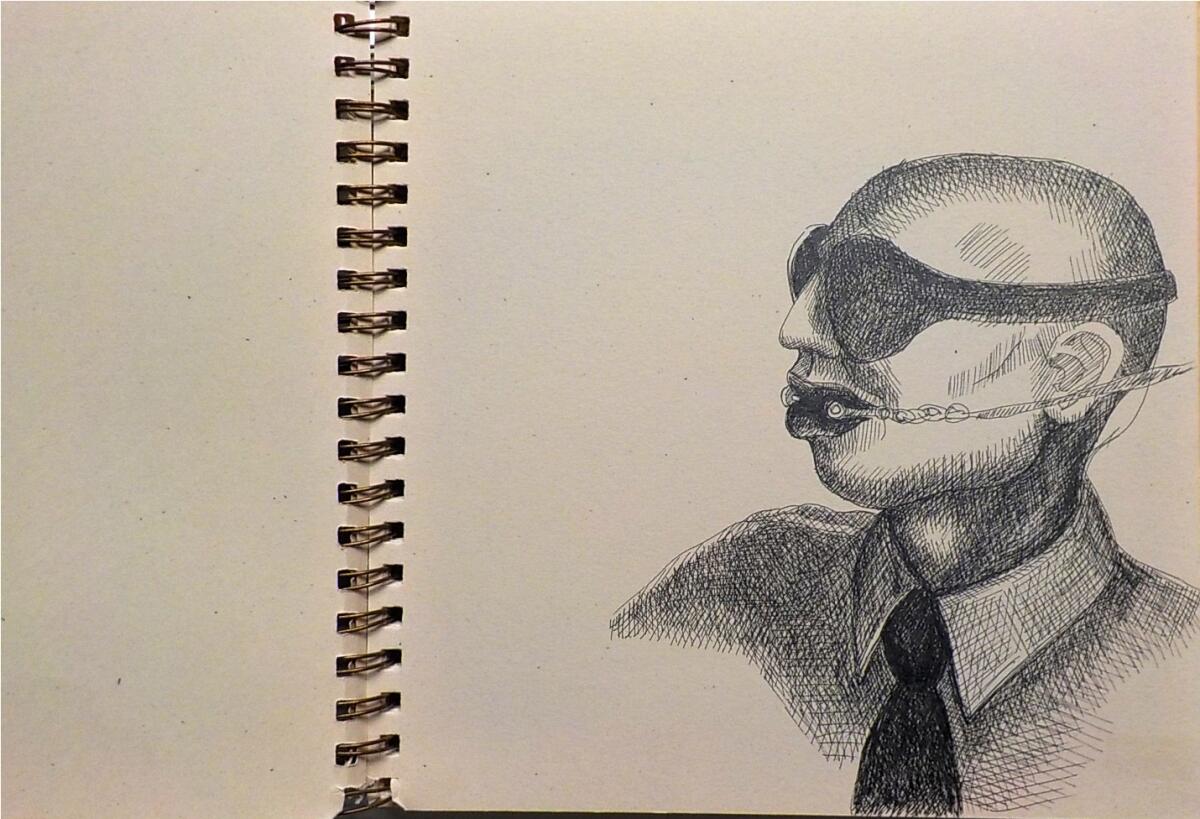
We were interviewing him because of his connection to the ’60s and the Chicago 7. He talks about that era being the “last idealist time.” He talks about a “generation of might-have-beens,” the “generation of lost innocence,” the “first televised war,” about a “half million soldiers in Vietnam” and “Sgt. Pepper’s Lonely Hearts [Club] Band” and “1 million self-described revolutionaries.”
He’s weaving these metaphors and I’m writing this stuff down and doing drawings. There is nothing I’ve ever made that doesn’t have a drawing. Even for the [sculptures] I have drawings. I’m thinking with my hand.
In murals, theater, photography and music, the Chicano Moratorium influenced art of its time and our time too.
In the early 1990s, Baca was commissioned to make a work of public art for the Metrolink station in Baldwin Park. “Danzas Indigenas” — “Indigenous Dances,” in English — featured the floor plan of the San Gabriel Mission over which was layered a diagram that revealed the steps for an Indigenous dance. In the ground and along a 20-foot arch, Baca placed a series of quotes that touched on currents in colonial history. Among them was a phrase that read, “It was better before they came.”
That quote led to controversy among anti-immigrant activists in 2005, who staged protests at the station — and accused Baca of promoting “militant” beliefs. Baca later said that the phrase had been uttered not by Indigenous people but by a white civic leader who was bemoaning the San Gabriel Valley’s rising Mexican population. By leaving ambiguous who “they” might be, her aim had been to provoke discussion. The MOLAA retrospective includes sketches and images of the design as well as ephemera related to the protests.
That is 2005. People think this is all the advent of the Trump era. But if you are a Chicana artist from California, this is your life. If you try to do anything honest and real about the lives of our people, it becomes an articulation of something else. We are relegated to “the personal is political” or we’re supposed to do self-portraits and examine our kundalini. We are relegated to a realm where we’re not supposed to be affecting the world that we live in. We’re supposed to be in the kitchen making tortillas. That’s it. And that’s boring. I was interested in dealing with power.
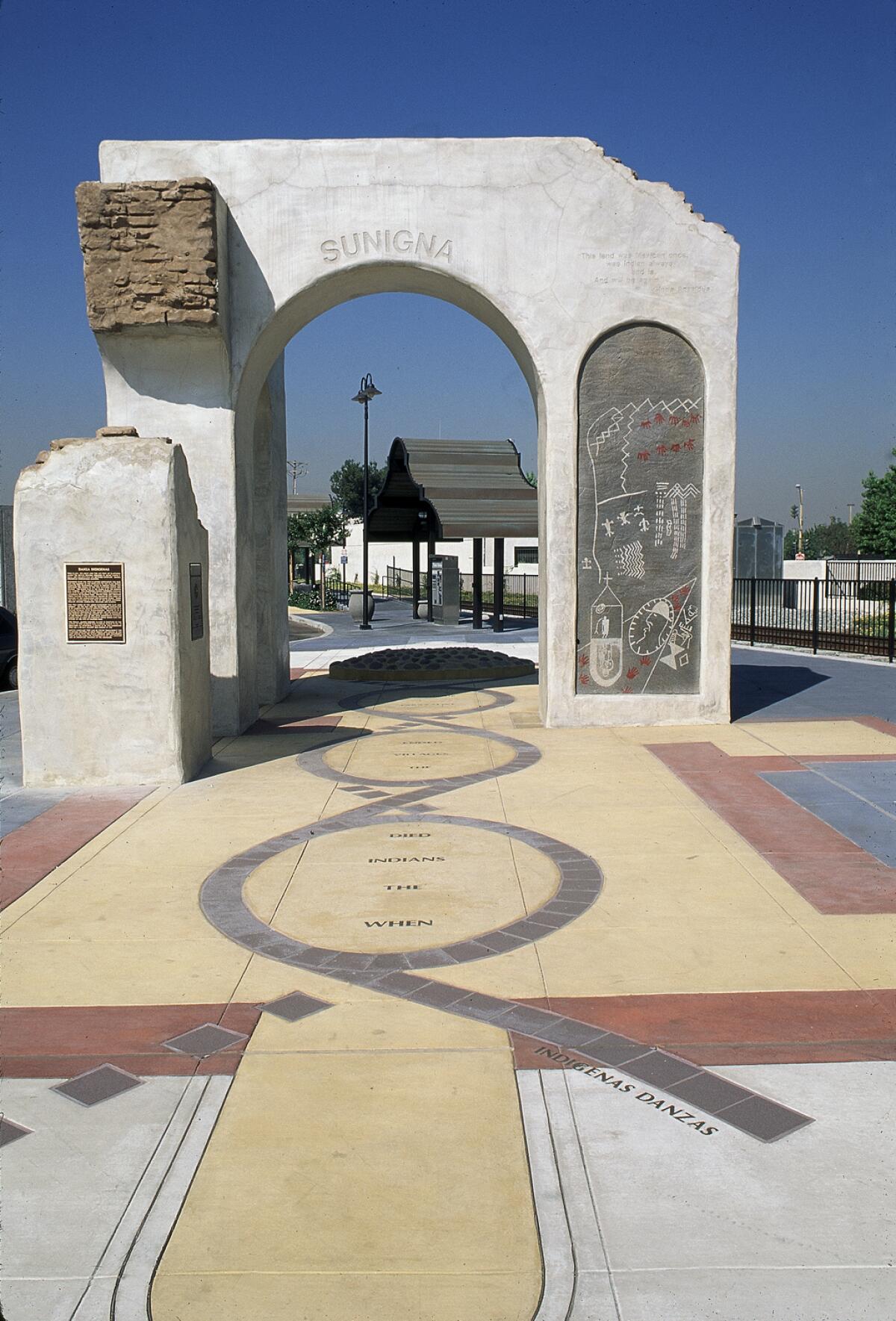
I was also thinking about the process — so that this would not be some superimposition on top of people. I went and did all of these interviews to start my process and start looking at the site. I wanted to do something real. I wanted to come up with plans and ideas that really spoke to the multiple generations of ethnicities in the area. I worked with Vera Rocha and her husband, Manuel [Rocha] — she was a leader of the Tongva. She said, “If you want to do something, bring back Toypurina.”
Toypurina had led this revolt against the Spanish in the 1780s. So [for “Danzas Indigenas”] I made a prayer mound for her and I used the language — the five Indigenous languages — in it. For the arch, I built the mission shape but I did it in the four directions of the Indigenous people. I created a pattern on the ground that was the dances of Indigenous people. It was like a map. Each of the seating areas has a bench shaped like a metate and a brand that marks the cattle of that region. Below that you have the shape of a village, since the Spanish villages were built on Indigenous villages.
Director Rick West helped turn the Autry Museum of the American West, once known for cowboy culture, into an important site of Indigenous art and life.
So I put all of this in the ground — in the land — and I dedicated it to Toypurina. And these protesters then came from like 80 miles away to protest it. That’s where the process became important, all of the work I’d done in advance. The people [in that community] rallied. They spoke on behalf of the monument. The artist almost became secondary. It had a dialogue going on in the public without me. Working from the bottom up and considering all the voices is so important.
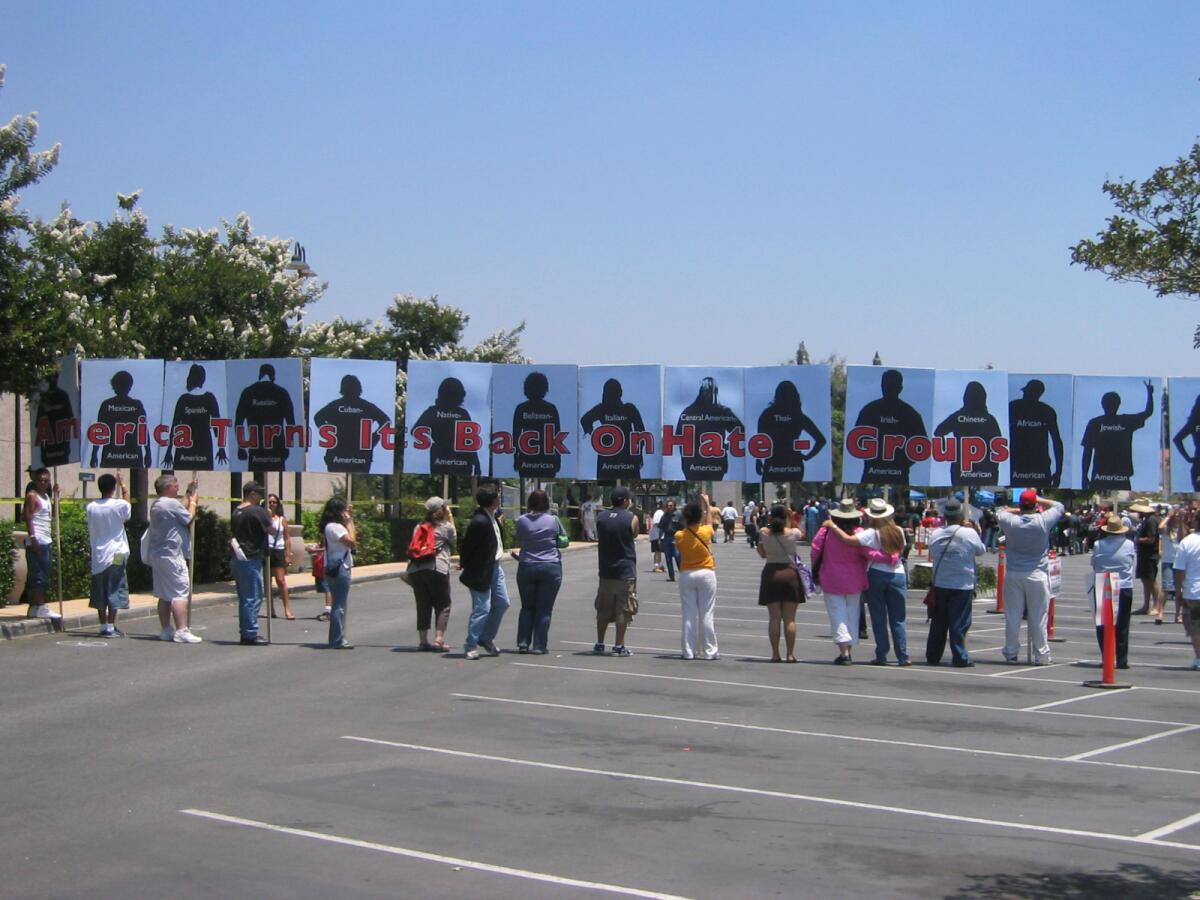
For the show at MOLAA, Baca’s signature work is presented as an immersive multimedia experience designed by Raubtier Productions, Unicus and Omagic Creative Production Team. With a nod to the future, the curators also included drawings for the mural’s planned expansion.
It was this idea that grew. [In the ‘70s], the idea at first was to do a 1,000-foot mural and have this experience with the kids. Then it became this chronology. And then it became this record of Los Angeles and of the river, which was being contained. It has been a dream for years to bring it to the present. It’s never been funded to do the whole thing. People wanted to fund me to work with the kids but they don’t want to fund the development of the work — and that takes time. And because of the location, it needs a lot of infrastructure.

There is also the work on the mural itself. Part of what I’ve been thinking about is the ’60s: there are three or four assassinations of major import, one of which took place in L.A. [the assassination of Robert F. Kennedy at the Ambassador Hotel in 1968]. There is the [1970] Chicano Moratorium. There are the sit-ins at lunch counters. We are talking about trying to end Jim Crow. I work with a team of people — university kids in this case. I’m refining every drawing. I am trying to get in the moment and get in the view. This is all sentiment that I have been alive for.
All these years later, I’m still working on the Great Wall. That is surprising. But having the continual connection to people working on it, and hearing from them now that they are adults, what it meant to them — some of these kids come back to me and say, “It changed how I perceive other people.”
Those moments, where I see that — that is creative work, collaborative work. It’s about creating community. I’ve been interrogating the types of monuments we’ve been building for years. Now there is a whole field of “public practice,” which used to be called community arts.
I’ve been doing that since the beginning.
Judy Baca: Memoria de Nuestra Tierra, A Retrospective
Where: Museum of Latin American Art, 628 Alamitos Ave., Long Beach
When: Through March 27, 2022
Info: molaa.org
The biggest entertainment stories
Get our big stories about Hollywood, film, television, music, arts, culture and more right in your inbox as soon as they publish.
You may occasionally receive promotional content from the Los Angeles Times.